Acquired Hemophilia A Understanding
Acquired Hemophilia A: Overview
Acquired hemophilia A is a disorder of rare entity, resulting in spontaneous bleeding in individuals with no history of bleeding disorders. It is believed to be caused by spontaneous inhibition of clotting factor VIII by autoantibodies, and is usually associated with other autoimmune conditions. The hallmark of this condition is mucocutaneous bleeding leading to ecchymosis, melena, hematoma or hematuria. The main form of hemophilia is hemophilia A, which is an X-linked disorder that mostly affects males but can also affect females.Symptoms
Acquired hemophilia can be difficult to diagnose due to its rare occurrence. The most common symptoms include:- Excessive bleeding into the skin
- Heavy and persistent bleeding after surgery
- Many large or deep bruises
- Blood in Urine or stool
- Nosebleeds without unknown cause
Diagnosis
Acquired Hemophilia is suspected by the clinical picture and confirmed by an abnormal coagulation test. A diagnosis should be considered with a recent onset of abnormal bleeding and an isolated prolongation of the activated partial thromboplastin time (aPTT). A factor VIII test is performed to measure the amount of factors in blood. A second specific test is performed to determine the amount of antibody, called a Bethesda inhibitor assay.Treatment
The specific therapeutic procedures and interventions vary, depending upon numerous factors including the specific symptoms present; the natural course of the disorder including underlying cause; age and overall health and other factors. Bypassing agents are the recommended first-line therapy due to their rapid action and high level of effectiveness. The bypassing agents presently available are recombinant activated factor VIII or activated prothrombin complex concentrate. Other treatment options involve use of corticosteroids alone or associated with cyclophosphamide.Acquired Hemophilia A Emerging Drugs Chapters
This segment of the Acquired Hemophilia A report encloses its detailed analysis of various drugs in different stages of clinical development, including phase II, I, preclinical and Discovery. It also helps to understand clinical trial details, expressive pharmacological action, agreements and collaborations, and the latest news and press releases.Acquired Hemophilia A Emerging Drugs
- Marstacimab:Pfizer
- Mim8: Novo Nordisk
- Eptacog Beta (LR769): Hema Biologics
Acquired Hemophilia A: Therapeutic Assessment
This segment of the report provides insights about the different Acquired Hemophilia A drugs segregated based on following parameters that define the scope of the report, such as:Major Players in Acquired Hemophilia A
There are approx. 10+ key companies which are developing the therapies for Acquired Hemophilia A. The companies which have their Acquired Hemophilia A drug candidates in the mid to advanced stage, i.e. phase III and Phase II include, Pfizer and others.Phases
The report covers around 10+ products under different phases of clinical development like
- Late-stage products (Phase III)
- Mid-Stage products (Phase II)
- Early-stage products (Phase I) along with the details of
- Pre-clinical and Discovery stage candidates
- Discontinued & Inactive candidates
Route of Administration
Acquired Hemophilia A pipeline report provides the therapeutic assessment of the pipeline drugs by the Route of Administration. Products have been categorized under various ROAs such as- Subcutaneous
- Intravenous
- Oral
Molecule Type
Products have been categorized under various Molecule types such as
- Small molecules
- Peptides
- Bi-specific antibody
Product Type
Drugs have been categorized under various product types like Mono, Combination and Mono/Combination.Acquired Hemophilia A: Pipeline Development Activities
The report provides insights into different therapeutic candidates in phase II, I, preclinical and discovery stage. It also analyses Acquired Hemophilia A therapeutic drugs key players involved in developing key drugs.Pipeline Development Activities
The report covers the detailed information of collaborations, acquisition and merger, licensing along with a thorough therapeutic assessment of emerging Acquired Hemophilia A drugs.Report Highlights
The companies and academics are working to assess challenges and seek opportunities that could influence Acquired Hemophilia A R&D. The therapies under development are focused on novel approaches to treat/improve Acquired Hemophilia A.Acquired Hemophilia A Report Insights
- Acquired Hemophilia A Pipeline Analysis
- Therapeutic Assessment
- Unmet Needs
- Impact of Drugs
Acquired Hemophilia A Report Assessment
- Pipeline Product Profiles
- Therapeutic Assessment
- Pipeline Assessment
- Inactive drugs assessment
- Unmet Needs
Key Questions
Current Treatment Scenario and Emerging Therapies:
- How many companies are developing Acquired Hemophilia A drugs?
- How many Acquired Hemophilia A drugs are developed by each company?
- How many emerging drugs are in mid-stage, and late-stage of development for the treatment of Acquired Hemophilia A?
- What are the key collaborations (Industry-Industry, Industry-Academia), Mergers and acquisitions, licensing activities related to the Acquired Hemophilia A therapeutics?
- What are the recent trends, drug types and novel technologies developed to overcome the limitation of existing therapies?
- What are the clinical studies going on for Acquired Hemophilia A and their status?
- What are the key designations that have been granted to the emerging drugs?
Key Players
- Pfizer
- Novo Nordisk
- Hema Biologics
- Hoffman-La-Roche
- Takeda
Key Products
- Mim8
- LR769
- TAK-672
- Marstacimab
- Emicizumab
This product will be delivered within 2 business days.
Table of Contents
Companies Mentioned (Partial List)
A selection of companies mentioned in this report includes, but is not limited to:
- Pfizer
- Novo Nordisk
- Hema Biologics
- Hoffman-La-Roche
- Takeda








